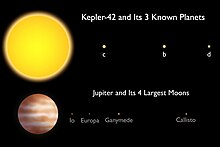Kepler-42
| Stern Kepler-42 | |||||
|---|---|---|---|---|---|
 | |||||
| Künstlerische Darstellung von Kepler-42 und seinem Planetensystem | |||||
| AladinLite | |||||
| Beobachtungsdaten Äquinoktium: J2000.0, Epoche: J2000.0 | |||||
| Sternbild | Schwan | ||||
| Rektaszension | 19h 28m 52,57s [1] | ||||
| Deklination | +44° 37′ 9″ [1] | ||||
| Bekannte Exoplaneten | 3 [2] | ||||
| Helligkeiten | |||||
| Scheinbare Helligkeit | 16,12 mag [3] | ||||
| Spektrum und Indices | |||||
| R−I-Index | (2,26) [1] | ||||
| Spektralklasse | M5 V [4] | ||||
| Astrometrie | |||||
| Radialgeschwindigkeit | −84,48 ± 0,2 km/s [4] | ||||
| Parallaxe | (24,93 ± 0,04) mas [1] | ||||
| Entfernung | (130,77 ± 0,22) Lj 40,11 ± 0,06 pc | ||||
| Eigenbewegung [1] | |||||
| Rek.-Anteil: | (93,13 ± 0,07) mas/a | ||||
| Dekl.-Anteil: | (−417,42 ± 0,07) mas/a | ||||
| Physikalische Eigenschaften | |||||
| Masse | 0,13 ± 0,05 M☉ [4] | ||||
| Radius | 0,17 ± 0,04 R☉ [4] | ||||
| Leuchtkraft | |||||
| Effektive Temperatur | 3.068 ± 174 K [4] | ||||
| Metallizität [Fe/H] | −0,48 ± 0,17 [4] | ||||
| Andere Bezeichnungen und Katalogeinträge | |||||
| |||||
Kepler-42 (auch KOI-961) ist ein Roter Zwerg im Sternbild Schwan, der etwa 130 Lichtjahre von der Sonne entfernt ist. Der Stern besitzt ein Planetensystem mit drei bekannten Exoplaneten.
Eigenschaften
Kepler-42 weist nur etwa 13 % der Sonnenmasse und etwa 17 % des Sonnenradius auf. Er ist damit etwas kleiner und masseärmer als Barnards Pfeilstern, der zu den nächsten Nachbarn der Sonne zählt. Wie dieser hat Kepler-42 auch eine hohe Eigenbewegung.[4] Seine Metallizität beträgt etwa ein Drittel der Sonne.
Planetensystem

Durch das Weltraumteleskop Kepler konnten mittels der Transitmethode drei Planeten nachgewiesen werden, die den Stern umkreisen. Die Entdeckung wurde im Januar 2012 bekanntgegeben.[4][5]
Alle drei Planeten haben einen geringeren Radius als die Erde und gehören zu den kleinsten bis Anfang 2012 entdeckten Exoplaneten. Der äußerste Planet Kepler-42d hat einen Radius etwas größer als Mars im Sonnensystem. Die Planeten umkreisen ihren Zentralstern in sehr geringer Entfernung und innerhalb sehr kurzer Zeit. So benötigt der innerste Planet Kepler-42c weniger als einen halben Erdtag für eine Umkreisung des Sterns. Bei allen Planeten handelt es sich wahrscheinlich um Gesteinsplaneten, die jedoch wegen ihrer sternnahen Umlaufbahnen viel zu heiß sind und sich damit außerhalb der habitablen Zone von Kepler-42 befinden.[5]
Das Planetensystem von Kepler-42 ähnelt von seinem Aufbau her dem Planeten Jupiter und seinen vier großen Monden Io, Europa, Ganymed, und Kallisto.[5] Zum Zeitpunkt seiner Entdeckung war es das kompakteste bekannte Planetensystem überhaupt.
| Planet (nach Entfernung vom Stern) | Entdeckung (Jahr) | Radius (in ) | Umlaufzeit (in Tagen) | Große Halbachse (in AE) |
|---|---|---|---|---|
| Kepler-42c | 2012 | 0,73 ± 0,20 | 0,45328509 ± 0,00000097 | 0,0060 |
| Kepler-42b | 2012 | 0,78 ± 0,22 | 1,2137672 ± 0,0000046 | 0,0116 |
| Kepler-42d | 2012 | 0,57 ± 0,18 | 1,865169 ± 0,000014 | 0,0154 |
Weblinks
Einzelnachweise
- ↑ a b c d KOI-961. In: SIMBAD. Centre de Données astronomiques de Strasbourg, abgerufen am 7. Dezember 2018.
- ↑ a b c Kepler-42. In: NASA Exoplanet Archive. Abgerufen am 7. Dezember 2018.
- ↑ Planet Kepler-42 b. In: Extrasolar Planets Encyclopaedia. Abgerufen am 7. Dezember 2018.
- ↑ a b c d e f g h Muirhead et al.: Characterizing the Cool KOIs III. KOI-961: A Small Star with Large Proper Motion and Three Small Planets. arxiv:1201.2189.
- ↑ a b c National Aeronautics and Space Administration: NASA's Kepler Mission Finds Three Smallest Exoplanets. Abgerufen am 29. Mai 2015.
Auf dieser Seite verwendete Medien
Opaque red circle
Autor/Urheber: IAU and Sky & Telescope magazine (Roger Sinnott & Rick Fienberg), Lizenz: CC BY 4.0
IAU Cygnus chart
Mini Planetary System
This artist's concept depicts an itsy bitsy planetary system -- so compact, in fact, that it's more like Jupiter and its moons than a star and its planets. Astronomers using data from NASA's Kepler mission and ground-based telescopes recently confirmed that the system, called Kepler-42 (formerly KOI-961), hosts the three smallest exoplanets known so far to orbit a star other than our sun. An exoplanet is a planet that resides outside of our solar system.
The star, which is located about 130 light-years away in the Cygnus constellation, is what's called a red dwarf. It's one-sixth the size of the sun, or just 70 percent bigger than Jupiter. The star is also cooler than our sun, and gives off more red light than yellow.
The smallest of the three planets, called Kepler-42d (Formerly KOI-961.03), is actually located the farthest from the star, and is pictured in the foreground. This planet is about the same size as Mars, with a radius only 0.57 times that of Earth. The next planet to the upper right is Kepler-42b (formerly KOI-961.01), which is 0.78 times the radius of Earth. The planet closest to the star is Kepler-42c (formerly KOI-961.02), with a radius 0.73 times the Earth's.
All three planets whip around the star in less than two days, with the closest planet taking less than half a day. Their close proximity to the star also means they are scorching hot, with temperatures ranging from 350 to 836 degrees Fahrenheit (176 to 447 degrees Celsius). The star's habitable zone, or the region where liquid water could exist, is located far beyond the planets.
The ground-based observations contributing to these discoveries were made with the Palomar Observatory, near San Diego, Calif., and the W.M. Keck Observatory atop Mauna Kea in Hawaii.This artist's concept compares the Kepler-42 (formerly known as KOI-961) planetary system to Jupiter and the largest four of its many moons.
The Kepler-42 planetary system hosts the three smallest planets known to orbit a star beyond our sun (called Kepler-42b, Kepler-42c, Kepler-43d; formerly called KOI-961.01, KOI-961.02 and KOI-961.03). The smallest of these planets, Kepler-42d, is about the same size as Mars. All three planets take less than two days to whip around their star.
The planets were discovered using data from NASA's Kepler mission and ground-based telescopes. The Kepler-42 star is a tiny "red dwarf," just one-sixth the size of our sun. This planetary system is the most compact detected to date, with a scale closer to Jupiter and its moons than another star system.
The planet and moon orbits are drawn to the same scale. The relative sizes of the stars, planets and moons have been increased for visibility.



